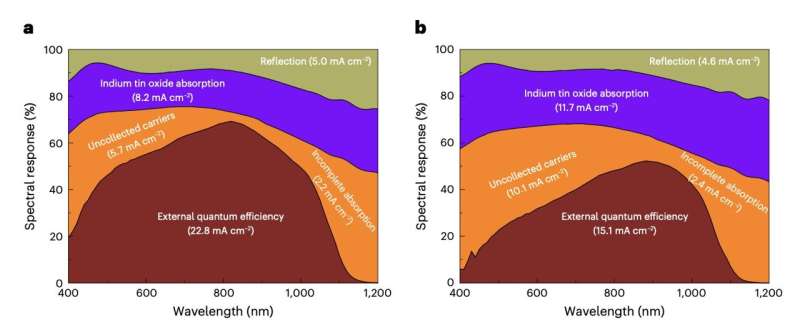To tackle global warming, engineers have been trying to develop increasingly advanced technologies that can generate and store electrical energy more sustainably. The most renowned among these technologies are solar cells, devices based on photovoltaic materials that can convert solar radiation into electricity.
One material that has recently attracted considerable attention for the development of solar cells is the absorber bifacial Cu(In,Ga)Se2, also referred to as CIGS. This material could be particularly promising for the creation of thin-film photovoltaics, due to its notable thermo-chemical stability.
Despite their advantages, CIGS-based solar cells often exhibit unsatisfactory power conversion efficiencies, particularly when tested outside laboratory settings. This greatly hinders their potential, preventing them from being produced and implemented on a large-scale.
Researchers at the Swiss Federal Laboratories for Materials Science and Technology, National Tsing Hua University and University of Cantabria have recently devised a strategy that could help to boost the power conversion efficiencies of CIGS thin-film solar cells.
This strategy, introduced in a paper published in Nature Energy, entails the use of a silver-assisted low-temperature process to prevent the formation of GaOx at the interface between the CIGS layer and a transparent-conducting-oxide, which is known to impair the cells' performance.
"We prevented the formation of GaOx by silver-promoted low-temperature growth of the CIGS layer," Shih-Chi Yang and his colleagues wrote in their paper. "This process also led to an improvement in the absorber quality, a steep Ga gradient near the back interface and reduced the absorption of the transparent conducting oxide."
Essentially, the researchers added a small amount of silver (4–5% AAC) to the CIGS absorbers, using a low-temperature deposition process. This process prevents the formation of GaOx at the CIGS/ITO interface, resolving issues typically observed in CIGS-based solar cells.
To demonstrate the potential of this silver-assisted low-temperature process, the researchers used it to create a series of cells, and then assessed their performance in an experimental setting. These initial tests yielded very promising results, as their strategy appeared to enable notably high power conversion efficiencies, which were overall greater than those of the other previously developed CIGS cells that they were compared to.
"We also report a certified bifacial solar cell on a glass substrate with efficiencies of 19.77% and 10.89% under front and rear illumination, respectively," Yang and his colleagues wrote in their paper. "We also fabricated bifacial solar cells directly on flexible substrates. Finally, we prepared bifacial perovskite/CIGS tandem solar cells in a four-terminal configuration, achieving a power generation density of 28.0 mW cm-2 under 1 sun and 30% albedo illumination."
In the future, the new strategy devised by this team of researchers could pave the way towards the commercialization and widespread deployment of CIGS solar cells. In addition, their work could inspire other teams to develop similar approaches for improving the performance of thin-film photovoltaics.
